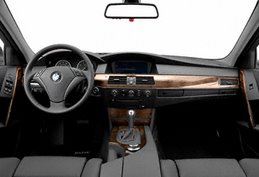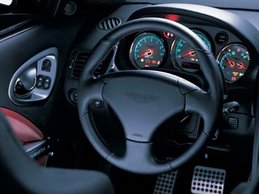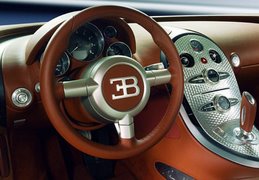 2006 Chevrolet Impala SS - After stepping out from behind the wheel, the driver can’t help being impressed by the SS’s power and its ability to generate astonishing numbers — 0 to 60 in 5.6 seconds, for one. The SS seems to have been created to produce impressive numbers on paper with little regard to driver enjoyment.
2006 Chevrolet Impala SS - After stepping out from behind the wheel, the driver can’t help being impressed by the SS’s power and its ability to generate astonishing numbers — 0 to 60 in 5.6 seconds, for one. The SS seems to have been created to produce impressive numbers on paper with little regard to driver enjoyment.Redesigned inside and out for 2006, the Impala rides on GM’s front-drive W-body platform that is the basis for the Buick LaCrosse, Pontiac Grand Prix, and Chevy Monte Carlo. Substantial tweaks and engineering sweat have been poured into the platform since it debuted 18 years ago as the GM10. This year’s biggest news would have to be the availability of a small-block V-8 in the Impala SS, Monte Carlo SS, and Grand Prix GXP (C/D, October 2005).
However, they didn’t repeal any laws of front-drive physics. The SS has so much power going to its front tires that when the traction control is engaged, the tires hunt for grip and the steering wheel tugs sharply to the left or right. The culprit is the traction control. As it engages each front brake to combat slip, torque is sent back and forth between the tires. We thought it was torque steer until Mark Clawson, the Impala’s marketing manager, pointed out that if you switch off the traction control, the car will spin the front tires with nary a twitch from the leather-wrapped wheel. However, this only occurs on billiard-table-smooth roads with the car pointed straight ahead; the slightest imperfection or steering input sets the tires on different missions, and the car gives the feeling that it’s waging war with itself.
The SS’s quicker acceleration can likely be traced to its shorter final-drive ratio (3.29:1 vs. 2.93). It’s also interesting to note that this level of acceleration is accomplished with a four-speed automatic — that’s called making the most of what you’ve got. But despite this performance, the Impala isn’t convincing as a sports sedan.
Part of the reason the Impala SS feels so uncomfortable with the V-8’s power is that it doesn’t benefit from all the chassis tweaks bestowed on the Grand Prix GXP. Opt for the Chevy, and you do
 n’t get the Pontiac’s wider front wheels and sticky Bridgestone tires, Bilstein shocks, and larger brakes. Although the SS’s chassis gets its own special anti-roll bars, bushings, and shock and spring rates, the suspension simply monkeys around too much. Any sporting input is foiled by a mess of undamped and uncontrolled body motions.
n’t get the Pontiac’s wider front wheels and sticky Bridgestone tires, Bilstein shocks, and larger brakes. Although the SS’s chassis gets its own special anti-roll bars, bushings, and shock and spring rates, the suspension simply monkeys around too much. Any sporting input is foiled by a mess of undamped and uncontrolled body motions.On the skidpad, the SS clung to the tune of 0.81 g — only 0.01 g less than the summer-tire-equipped GXP. Reality: The Impala leaned over far enough to be included in Who’s Who in Body Roll. Making the roll feel even more pronounced are flat, unsupportive, and slippery leather seats that require the driver to brace against the door.
Even at slower speeds, and despite the soft tuning, the front-strut suspension crashes over pavement imperfections as if someone had overlooked the advantages of bushings. It’s admittedly a minor annoyance but one that makes the car feel unrefined and crude and demonstrates the limitations of the old platform. The SS’s fraternal twin, the Grand Prix GXP, makes the same noises, but the competition doesn’t.
Fortunately, the car is capable of making some very satisfying sounds. Fire up the SS with the standard remote starter, and you’ll have the pleasure of walking up to an unmistakable V-8 beat emanating from the dual exhaust and entering a warm car (or a cool one). Inside, the rumble is kept to a dull roar by some well-placed insulation and a fire wall made of Quiet Steel that reduces unwanted noise. On the highway, road and tire noise barely make it into the cabin; most of the 70 dBA of noise at 70 mph is likely attributable to the wind.
Keep the dynamic challenges to a minimum, and one begins to notice the well-laid-out and uncluttered interior. Although the plastics aren’t of the soft variety, the interior appears bolted together nicely, and all the controls are easy to use.
Our test car came equipped with only a few options — the $1125 black-leather interior with heated, power front seats; and a Bose stereo system with an in-das
 h six-CD changer and XM-satellite-radio capability. We appreciated the auxiliary port on the radio that allows one to plug in an MP3 player.
h six-CD changer and XM-satellite-radio capability. We appreciated the auxiliary port on the radio that allows one to plug in an MP3 player.Since we love the idea of a family car coming with a major dose of power and performance, we had great expectations for the Impala SS. We also understand that many buyers want something a bit more rambunctious, more invigorating than a Honda Accord or Toyota Camry or Ford Five Hundred. But as noted, the V-8 transplant wasn’t as successful in the Impala as it was in the Grand Prix. Try to exploit the SS’s extra oomph, and there is little reward.













No comments:
Post a Comment